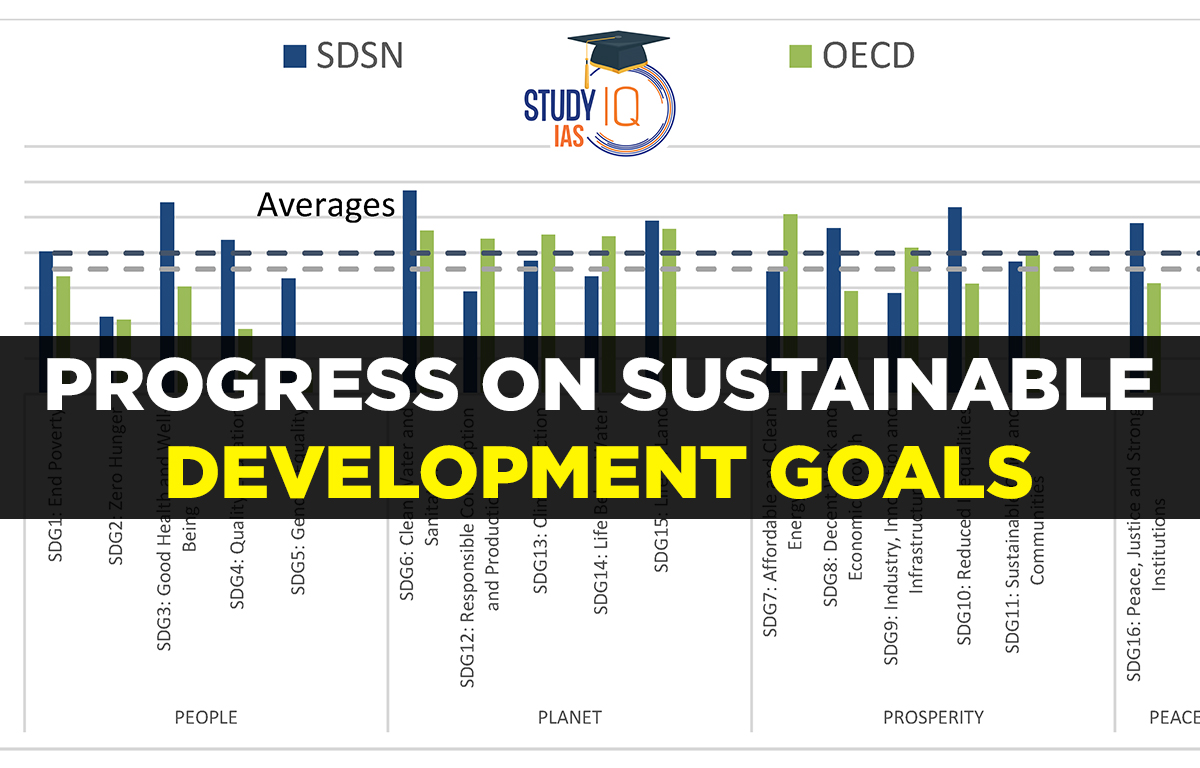Table of Contents
Context: The Lancet has recently published a mid-line assessment of the progress across 707 districts of India for 33 SDG indicators related to health and social determinants of health.
Methodology of the Study
- Data collected on children and adults from two rounds of the National Family Health Survey (NFHS) conducted in 2016 and 2021 were used.
- 33 indicators that cover 9 of the 17 official SDGs were identified.
- The goals and targets outlined by the Global Indicator Framework, Government of India and World Health Organization (WHO) to determine SDG targets to be met by 2030 were used.
- Precision-weighted multilevel models were used based on which district mean for 2016 and 2021 was calculated and using these values, the Annual Absolute Change (AAC) for each indicator was measured.
- Using the AAC and targets, India and each district was classified as: Achieved-I, Achieved-II, On-Target and Off-Target.
Findings of the Study
- India is not On-Target for 19 of the 33 SDGs indicators.
- The critical Off-Target indicators include Access to Basic Services, Wasting and Overweight Children, Anaemia, Child Marriage, Partner Violence, Tobacco Use, and Modern Contraceptive Use.
- For these indicators, more than 75% of the districts were Off-Target.
- These Off-Target districts are concentrated in the states of Madhya Pradesh, Chhattisgarh, Jharkhand, Bihar, and Odisha.
- It does not appear that Aspirational Districts, on average, are performing better in meeting the SDG targets than other districts on majority of the indicators.
National Level Status on Meeting SDG Targets
- At the all-India level, the one SDG indicator that has already been achieved (Achieved-I) is Adolescent Pregnancy (10–14).
- India is On-Target to meet 13 out of the 33 indicators, namely, Internet Use, Have Bank Account (Women), Full Vaccination (Card), Improved Sanitation, Multidimensional Poverty, Birth Registration, Skilled Birth Attendants, Electricity Access, Tobacco Use (Women), Child Marriage Girl (<15), Under 5 Mortality, Teenage Sexual Violence and Neonatal Mortality.
- India remains Off-Target on 19 indicators.
- Since the prevalence has increased (worsened) for 3 of these, Anaemia among Women, Pregnant, and Non-Pregnant Women between 2016 and 2021, and assuming this trend continues, India would never be able to meet the SDG targets related to Anaemia.
- For the remaining 16 indicators that are Off-Target, the observed rate of change between 2021 and 2016 is insufficient to meet SDG targets by 2030.
- Among the Off-Target indicators, India will meet its targets on Improved Water (2031), Hand Washing Facility (2033), Clean Fuel for Cooking (2035), Teenage Pregnancy (15–19) (2039), and Partner Violence (Sexual) (2040).
District-wise Status of SDG Indicator Performance
- There is substantial disparity across districts with regards to the categories of Achieved, On-Target and Off-Target.
- The maximum number of SDG indicators that have been achieved by any district is 13 (out of a possible 33) met by Lakshadweep and Ernakulam (Kerala).
- The 61 districts that have achieved 9–13 indicators are largely located in the states of Kerala, Tamil Nadu, Arunachal Pradesh, and Punjab.
- About 94 districts have achieved 7–8 indicators distributed across the states of Karnataka, Andhra Pradesh, Telangana, Gujarat, Haryana, Punjab, and Uttarakhand.
- Approximately 171 districts have achieved their target for 2 or less indicators, and are mostly located in central and eastern states such as Madhya Pradesh, Chhattisgarh, Assam, Odisha, and Jharkhand.
- The maximum number of indicators On-Target for any district is 23 and it is found in the district of Udaipur (Rajasthan).
- A total of 159 districts are On-Target to meet 3–8 indicators (lowest quintile), and are mostly located in Maharashtra, West Bengal, and Punjab.
- Every district in India is Off-Target on at least 6 indicators.
Sustainable Development Goals
- The SDGs were adopted by the United Nations in 2015 with a vision to achieve a better and more sustainable future for all.
- There are 17 goals and 169 specific targets to be achieved by 2030.
- SDGs are not legally binding.
- India is one of the signatory countries that has committed to achieving these goals by 2030.


 Bharat Bandh 9 July 2025: Over 25 Crore ...
Bharat Bandh 9 July 2025: Over 25 Crore ...
 UPPSC Mains Question Paper 2025: Downloa...
UPPSC Mains Question Paper 2025: Downloa...
 Sukhoi Su-57: Will India Choose Russia�...
Sukhoi Su-57: Will India Choose Russia�...





















